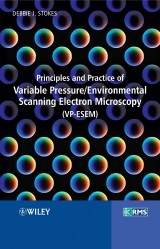Details

Principles and Practice of Variable Pressure / Environmental Scanning Electron Microscopy (VP-ESEM)
RMS - Royal Microscopical Society 1. Aufl.
|
68,99 € |
|
| Verlag: | Wiley |
| Format: | |
| Veröffentl.: | 20.11.2008 |
| ISBN/EAN: | 9780470758748 |
| Sprache: | englisch |
| Anzahl Seiten: | 240 |
DRM-geschütztes eBook, Sie benötigen z.B. Adobe Digital Editions und eine Adobe ID zum Lesen.
Beschreibungen
<ul> <li>Offers a simple starting point to VPSEM, especially for new users, technicians and students containing clear, concise explanations</li> <li>Crucially, the principles and applications outlined in this book are completely generic: i.e. applicable to all types of VPSEM, irrespective of manufacturer.</li> <li>Information presented will enable reader to turn principles into practice</li> <li>Published in association with the Royal Microscopical Society (RMS) -www.rms.org.uk</li> </ul>
<h2>Contents</h2> <p><b>Chapter 1</b> -<b>A brief historical overview</b></p> <p>1.1 Scanning electron microscopy</p> <p>1.2 The development of imaging in a gas environment</p> <p><b>Chapter 2</b> -<b>Principles of SEM</b></p> <p>2.1 Introduction</p> <p>2.2 Electron sources</p> <p>2.3 Electron optics</p> <p><a id="_Toc444904955" name="_Toc444904955"></a><a id="_Toc444500106" name="_Toc444500106"></a><a id="_Toc444499835" name="_Toc444499835"></a><a id="_Toc444497480" name="_Toc444497480">2.4 Signals and detection</a></p> <p>2.5 Practical aspects of electron beam irradiation</p> <p>2.6 the sem in operation</p> <p> </p> <p><b>Chapter 3</b> -<b>General principles of VP-ESEM: utilising a</b> gas</p> <p>3.1 Introduction</p> <p>3.2 VP-ESEM instrumentation</p> <p>3.3 Signal generation in a gas</p> <p>3.4 Imaging with water vapour </p> <p> </p> <p><b>Chapter 4</b> -<b>Imaging and analysis in the VP-ESEM: the influence of a gas</b></p> <p>4.1 Introduction</p> <p>4.2 Background to theoretical calculations </p> <p>4.3 Which gas?</p> <p>4.4 Exploring the gas path length</p> <p>4.5 How much gas?</p> <p>4.6 X-ray microanalysis in the VP-ESEM</p> <p> </p> <p><b>Chapter 5</b> -<b>Imaging uncoated specimens in the VP-ESEM</b></p> <p> 5.1 Introduction</p> <p>5.2 Electronic structure</p> <p>5.3 Factors affecting secondary electron emission</p> <p>5.4 The influence of the specimen on the system</p> <p>5.5 Time- and temperature-dependent effects</p> <p>5.6 imaging soft materials</p> <p>5.7 Effects of ions on imaging</p> <p>5.8 Imaging with a gas: summary</p> <p> </p> <p><b>Chapter 6</b> -<b>A lab in a chamber – in situ methods in VP-ESEM and other applications</b></p> <p> 6.1 Introduction</p> <p>6.2 Nanocharacterisation of insulating materials</p> <p>6.3 In situ experiments</p> <p>6.4 Other applications</p>
<p><b>Dr Debbie Stokes</b>, Academic Visitor, Cavendish Laboratory, University of Cambridge, UK and Director of MicroSci; Obtained her degree in polymers from Bristol University in 1994.<br /> In 1996 moved to Cavendish laboratory to do her Ph D on use of environmental SEM with Professor Athene Donald.<br />In 1999 became Royal Society Dorothy Hodgkin Research Fellow and a Junior Research Fellow of Newnham College, Cambridge, becoming a Senior Research Fellow in 2002.<br />Currently working at the Cavendish Laboratory funded by her consultancy business MicroSci.</p>
Scanning electron microscopy (SEM) is a technique of major importance and is widely used throughout the scientific and technological communities. The modern SEM is capable of resolution on the order of a few Angstroms (i.e. sub-nanometer), subject to the limits of electron-specimen interactions. However, for a long time it has been apparent that the high vacuum SEM needed to develop in respects other than increased resolution. Hence the advent of SEMs that utilise a gas for image formation while simultaneously providing charge stabilisation for electrically non-conductive specimens and/or a suitable environment for materials and experiments involving water. <p>This text outlines the principles and applications in a generic way, applicable to readers familiar with any of the types of VP-ESEM on the market, irrespective of manufacturer</p> <p>The book addresses various aspects of the topic in six chapters.</p> <ul> <li>Chapter 1 - <b>A brief historical overview</b> contains background information charting the development and growth of the technique and its underlying principles</li> </ul> <ul> <li>Chapter 2 - <b>Principles of SEM</b> gives an overview of various aspects of the conventional high vacuum SEM, in preparation for later chapters covering the greater variety of operating conditions associated with the VP-ESEM</li> </ul> <ul> <li>Chapter 3 - <b>General principles of VP-ESEM: utilising a</b> <b>gas</b> reviews the basic scientific principles of signal formation and collection in a gaseous environment, including specimen stability as a function of water vapour pressure and/or temperature.</li> </ul> <ul> <li>Chapter 4 - <b>Imaging and analysis in the VP-ESEM: the influence of a gas</b> looks at the properties and effects of different gases, pressures and primary electron energies, with particular attention to electron scattering and its effects on imaging and microanalysis</li> </ul> <ul> <li>Chapter 5 - <b>Imaging uncoated specimens in the VP-ESEM</b> briefly looks at the pros and cons of putting native-state materials in the VP-ESEM, such as primary electron beam penetration, radiation damage and, crucially, the properties of materials in an electric field and the influence of gaseous positive ions</li> </ul> <ul> <li>Chapter 6 - <b>A lab in a chamber – <i>in situ</i> methods in VP-ESEM and other applications</b> concludes the book with a survey of dynamic experiments such as: tensile testing, vapour-deposition of nanostructures, oxidation and reduction,lithography, ice crystallization and wetting of surfaces, to name a few, as well as unique imaging methods, plus an extensive review of the literature covering both hard and soft materials.</li> </ul> <p>This book is intended as a guide to help those that are just starting out with VP-ESEM, as well as those with more experience looking to gain a deeper appreciation of the concepts.</p>


















